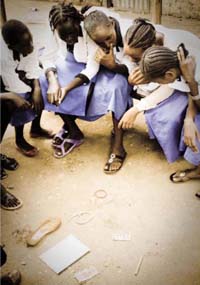Effective networking
To work effectively with the community, you need to understand who holds the power in the community and how they influence community decisions. The community has an important role to help identify health problems and use the available resources in the village to plan activities and then act to improve the community's health. For the successful implementation of development activities, you need to involve everyone in a community network, especially those with power (the decision makers in the community), as early and as often as possible.

You can engage the community using one or more of the participatory methods, such as small groups (Figure 19.7), large meetings, community conversation, local celebrations or exhibitions. You should also identify health objectives for your community, and use the right approaches to engage the whole community. Invite the whole community and representatives to meetings, and secure their approval for your advocacy objectives. Then ensure clarification of the roles of all the people involved.
If you had to express one overwhelming message about how to go about community mobilisation, which of the ones below would you choose?
- Invite only key opinion leaders to ensure that messages do not get confused.
- Prepare a health objective thoroughly yourself and then present it to community leaders.
- Invite the whole community to get involved as much as they can.
- Prepare a health objective which is 'right' for the community, and drive it through regardless of what they say.
We think the key message is to involve the community as much as you can (Number 3). If you conceive and carry out a plan only talking to opinion leaders, or only based on your own views, you will not have the community with you.
Community mobilisation at its best does not merely raise community awareness about an issue, or persuade people to participate in activities that have been prioritised and planned by others. Rather, it is a comprehensive strategy that includes exploring the health issues in the community, developing a plan of work, working with the community to establish credibility and trust, working together with the community to implement your plan, and raising community awareness about important health issues. It also involves working with community leaders, model families and others to make sure that those most affected by the health issues are involved in the necessary action.